Back to Biba Home Page / Back to Home Page / My Biba / My Biba 2
Book Signings
Biba @ the V&A
Starting life as a small mail-order business, Barbara Hulanicki's 'Biba' evolved into a style and retail phenomenon.

Barbara Hulanicki and Stephen Fitz-Simon, about 1960, photographer unknown. Biba archive. © Victoria and Albert Museum, London
The daughter of a Polish diplomat, Barbara Hulanicki moved to London with her family after the Second World War. She began her career in fashion in the early 1960s, working as a freelance illustrator after studying at Brighton College of Art. Her husband, Stephen Fitz-Simon, was an advertising executive at the time, and could see that illustration was quickly being eclipsed by photography. He encouraged her to pursue her interest in designing, and in 1963 the couple launched Biba's Postal Boutique ('Biba' was the nickname of Hulanicki's younger sister, Biruta). Run as a mail-order business that produced set runs of stock, Biba offered Hulanicki and Fitz-Simon a low-risk means of testing the popularity of new designs.
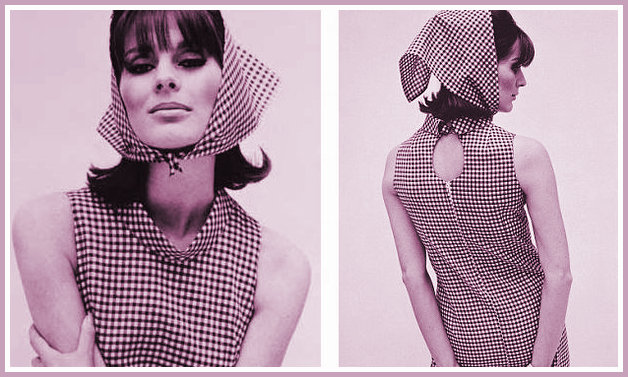
The label scored its first major success in 1964, with a pink-gingham sleeveless shift** dress and matching headscarf – a nod to the simple clothes Hulanicki's mother had made her when she was a girl. The dress was commissioned by Felicity Green, The Daily Mirror's influential fashion editor, who featured it in a sponsored promotion used to illustrate an article on women in business. It was anticipated that the dress would sell around 3,000 units, but once the feature was published, Biba received over 17,000 orders. With solid proof of a mass-market appetite for her fresh, youthful styles, Hulanicki had the confidence to open the first Biba boutique, in a former chemist's shop in London's Abingdon Road.
Women – mostly under the age of 25 – flocked to Biba to buy Hulanicki's 'Mod' clothes in the murky tones she soon became known for. Biba's aesthetic was inspired by decadent, bygone styles (particularly Pre-Raphaelite and Art Nouveau) in earthy colours like olive, rust and her favourite, 'bruised purple'. Where female fashions of the previous decades had emphasised the bust and hips, Hulanicki's short designs focused on the wearer's legs. Her outfits best accommodated women whose under-fed post-war bodies allowed them to squeeze into unforgiving dresses (stretch fabrics were yet to be invented), many of which featured Hulanicki's signature 'long and skinny' sleeves. By the middle of the decade, Biba had become one of the capital's 'must have' new labels. And word soon travelled: a 1966 edition of American news magazine Time promoted London as 'The Swinging City' and named Biba as "the most in shop for gear".
The key to Biba's success lay in its affordability. Fitz-Simon had worked out that if they kept prices well inside the maximum disposable weekly income of the average London secretary, they could accelerate the rate of repeat purchases. So the principle behind the Biba store was 'pile it high, sell it cheap', making it very different from other fashionable London boutiques that catered only for those with money. Hulanicki also had an eye for what ordinary girls liked, maintained a fast-changing supply of coordinated separates in a variety of colours. But it wasn't only students and young working women that appreciated a well-designed bargain – models, singers and TV celebrities (among them Twiggy, Cilla Black and the presenter of hip pop-music TV show Ready Steady Go!, Cathy McGowan) were also loyal Biba customers.
Shoppers also appreciated the unique atmosphere at Biba, which Hulanicki and Fitz-Simon had worked hard to create. Their store was filled with ornate Victorian furniture and antiques, was dimly lit for dramatic effect and – unusually for the time – offered a communal (and flimsy) changing room. They also hired young, approachable staff who looked and acted like the customers, and played loud pop music that leaked out onto the street. The retail experience was transformed. Shopping, very suddenly, became a social event. Many women from outside London made special trips to the capital just to shop at Biba.
In 1966 Biba opened a new store on Kensington Church Street, and later expanded into a former department store on Kensington High Street. Housed in this enormous Art Deco building (Hulanicki was a huge fan of the style), and diversifying into homeware lines, as well as running a restaurant and nightclub, Biba was now London's most renowned 'place to be'. Crucially, despite all the glamour of 'Big Biba', young people could still afford to go there and push through the crowds to secure the latest must-wear item – such as the knee-high boots, popular at the end of the decade.
Hulanicki lost outright control of the business in the mid-1970s when she and Fitz-Simon sold part of Biba to another UK fashion company, Dorothy Perkins. The Biba store closed in 1976. Hulanicki now lives in the US where she works as a retail and design consultant.
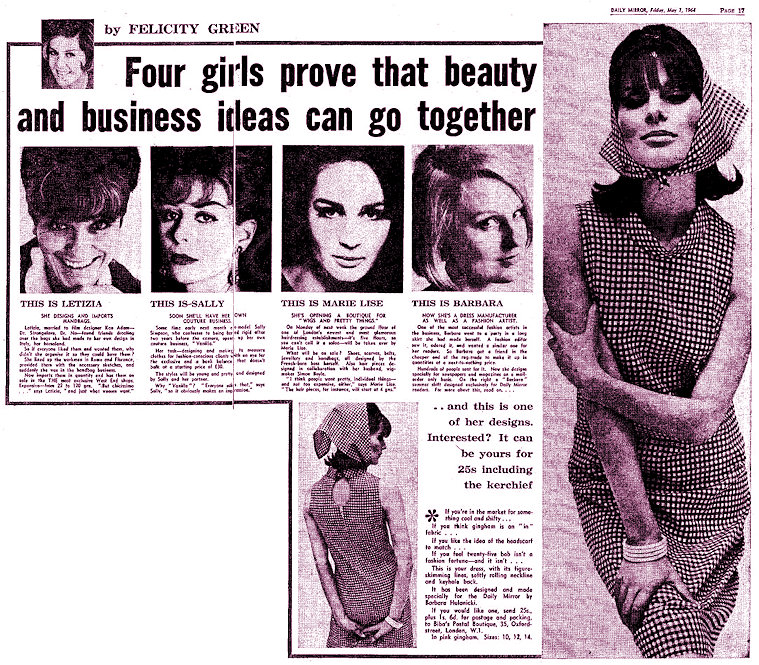
This is Barbara
Now she's a dress manufacturer as well as fashion artist.
One of the most successful fashion artists in the business, Barbara went to a party in a long skirt she made herself. A fashion editor saw it, ordered it, and wanted a similar one for her readers. So Barbara got a friend in the cheaper end of the rag-trade to make it up in quantities at a next-to-nothing-price.
Hundreds of people sent for it. Now she designs especially for newspapers and magazines on a mail-order only basis. On the right a "Barbara" Summer Shift designed exclusively for Daily Mirror readers. For more about this, read on .....
.. and this is one of her designs. Interested? It can be yours for 25s including the kerchief.
If you're in the market for something cool and shifty ...
If you like the idea of the headscarf to match ...
If you feel twenty-five bob isn't a fashion fortune - and it isn't ...
This is your dress, with its figure-skimming lines, softly rolling neckline and keyhole back.
It has been designed and made specially for the Daily Mirror by Barbara Hulanicki.
If you would like one, send 25s., plus 1s. 6d. for postage and packing, to Biba's Postal Boutique, 35, Oxford Street, London W.1
in pink gingham. Sizes 10,12,14
Biba: The Fashion. The Lifestyle. The Brand.
Beecroft Art Gallery & Central Museum - 28th May 2016 - 14th January 2017

"This exhibition explores the iconic brand from its humble beginnings as a postal clothing boutique, to its unprecedented success and expansion into the world of home wares, cosmetics, and even food. Biba and everything associated with it became a lifestyle aspiration for nearly all teenagers and young adults during the 1960s and 70s. Biba was the brainchild of Barbara Hulanicki, a fashion illustrator whose desire to create affordable fashion for all, saw the development of a business that would change the face of high street fashion, lifestyle wares and shopping forever.
Displayed across the Beecroft Art Gallery and Central Museum, this will be a joint exhibition celebrating all things Biba, highlighting the brands reach from fashion to personal health and lifestyle wares. A local and prolific collector of Biba has kindly loaned the objects in this exhibition, emphasising the importance and relevance of this brand today.
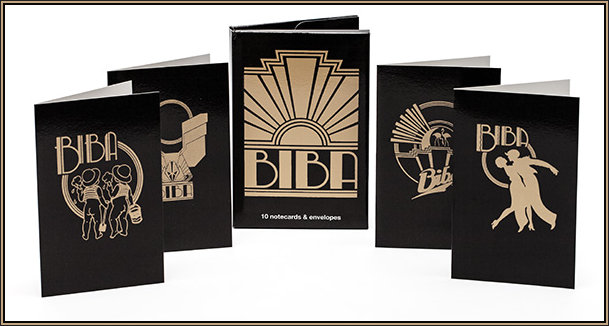
Some very classy repros for the Southend Exhibition but its still not the same as owning the originals!
With a completely new and unique atmosphere that appealed to all the senses, Biba was an experience that many will fondly remember. For those who are new to Biba, it will be an exciting and captivating journey through the history and character of the brand.
Enchanting and charismatic, Biba continues to make the mundane magical."
Biba and Beyond: Barbara Hulanicki
22 September 2012 to 14 April 2013 - Brighton Museum & Art Gallery
A new major fashion exhibition at Brighton Museum & Art Gallery celebrates all things Biba and Beyond! The Biba store, the clothes, the lifestyle and the far reaching influence of this iconic brand. The exhibition also looks at the life and times of the charismatic and talented woman behind the label, Barbara Hulanicki. It also includes her successful earlier career in fashion illustration and her later achievements in interior design and architecture.

Reproduction artwork available from Brighton Museums
After walking out of Biba in the mid-1970s following the brand’s corporate takeover, Barbara Hulanicki went on to work successfully in fashion in South America, Europe and Japan. In 2012 she is now an award winning and high profile interior designer working on major projects in the US and Caribbean. In the past few years Barbara’s career has come full circle with hugely successful affordable fashion projects in the UK for TopShop and George at Asda. 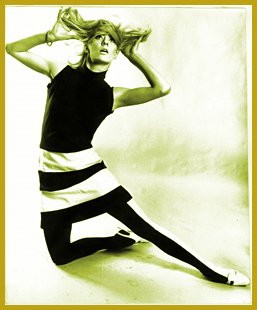
With its cutting edge yet affordable fashion, Barbara Hulanicki’s iconic Biba store and label transformed the High Street shopping experience in the 1960s and 70s. Young working women shopped alongside models and celebrities, including Twiggy, Cher and the Rolling Stones. Art Deco, Victorian and Hollywood glamour all combined in striking, romantic and sensual designs.
With loans from major collectors and private individuals the exhibition tells the amazing story through illustrations, film, fashion, music, photography, ephemera and the memories and reminiscences of those who shared the experience. There will also be items on display from the very successful ‘bring in your Biba’ day at Brighton Museum. Contributors were asked to bring in their Biba items and memories from the London and Brighton stores.
Plus Brighton Museum shop undergoes a transformation to become the city’s very own temporary Biba-inspired store influenced by the label’s quirky 60s and 70s style. Find reprints of original Biba books and posters, Biba inspired jewellery, mirrors and glassware, and fabulous accessories including a special collection of hats inspired by the iconic brand.
This golden haven for Biba lovers includes items commissioned especially for the shop, and maintains the Biba ethos of providing great products at affordable prices.
Model Vicky Hodge - Copyright Ron Falloon
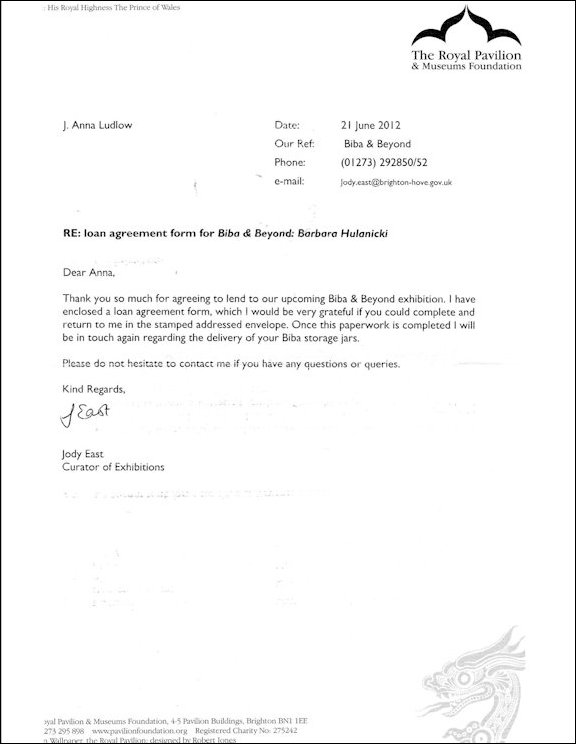

As you can see I was to have been involved with the Brighton Exhibition by formally lending my lovely jars - regrettably I was taken to hospital and the Museum did not follow up, but they did get a copy of 'Seamless' signed (and personalised) for me
The Laing Gallery - 1993
The Laing toured the exhibition and so I was present at both the opening in Newcastle and then in Loughborough where most of these images are from including me, not in a Biba frock (they were all in the exhibition) but I did have a Biba tie-die scarf about my neck and shoulders. My evening dress caused quite a stir, not only was it part of the exhibition but it is the first photo in the official programme and featured in the opening credits of 'The Clothes Show'!
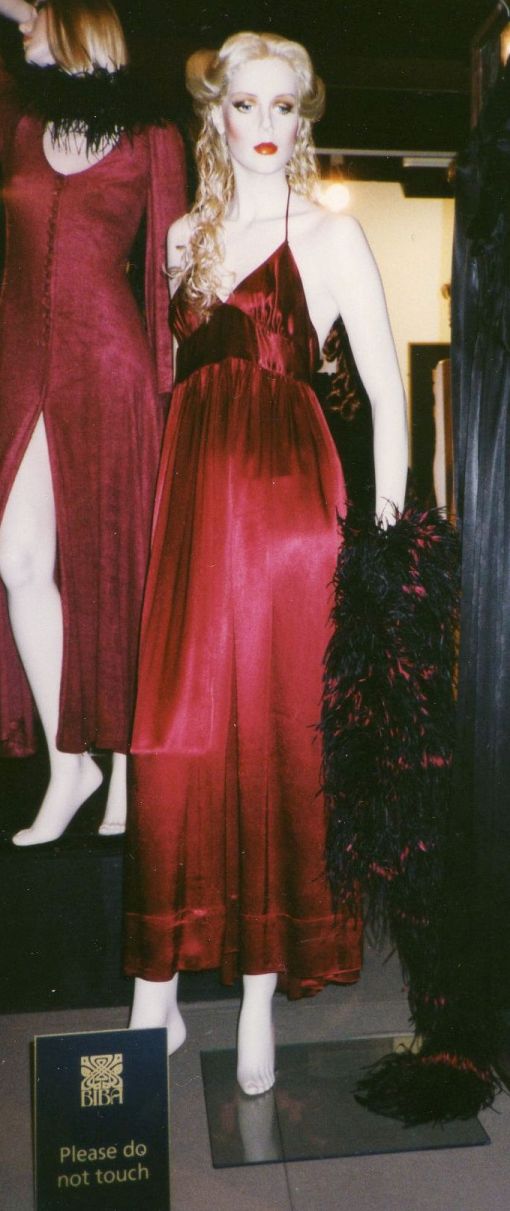
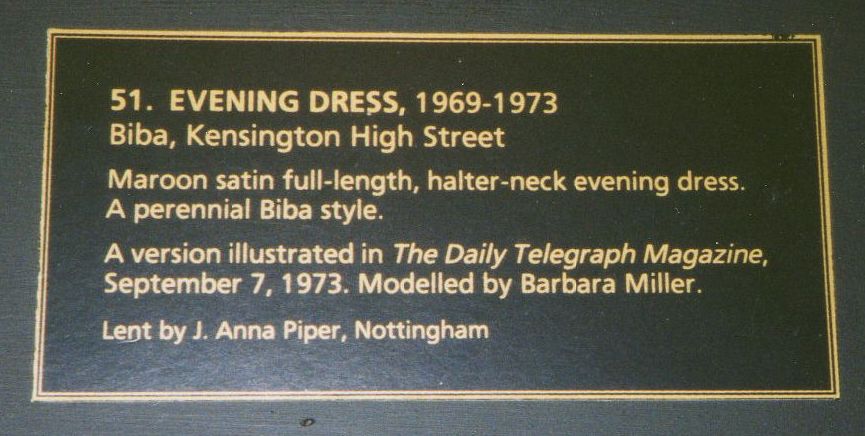
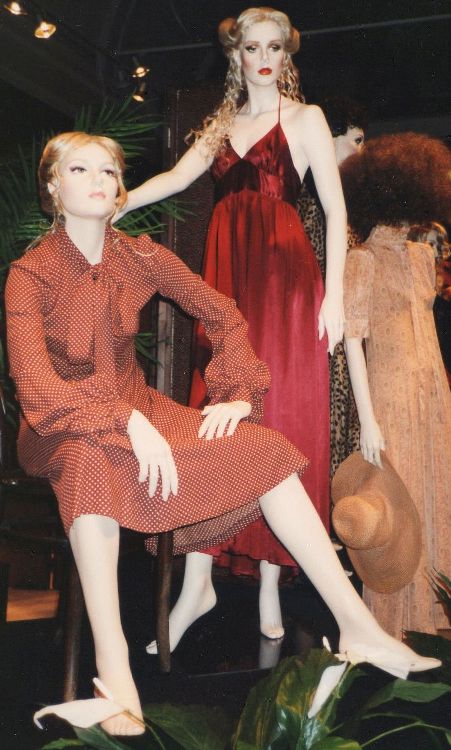
The finale of The Clothes Show 'framed' all the dresses that had featured.
The Clothes Show featuring my dress in the opening credits.
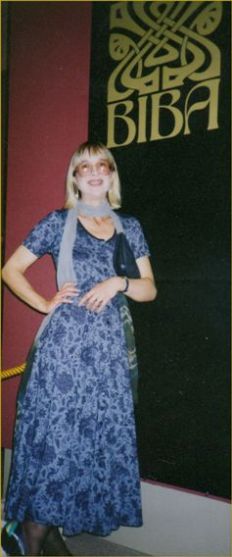
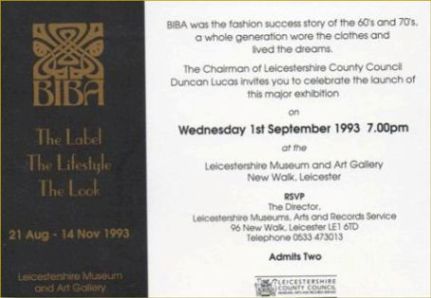
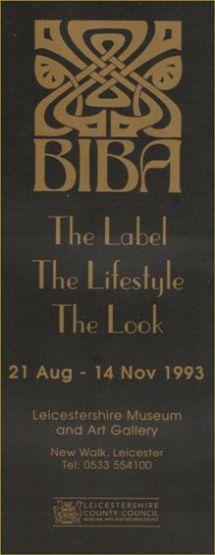
Me, my invitation and the Programme - there was cake too!
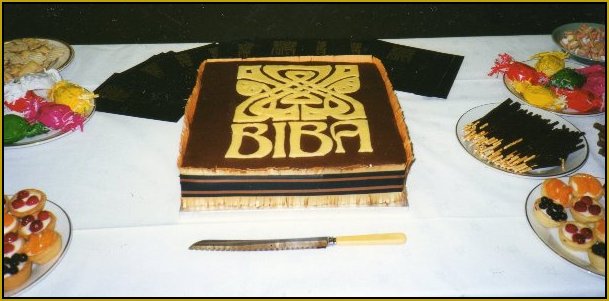
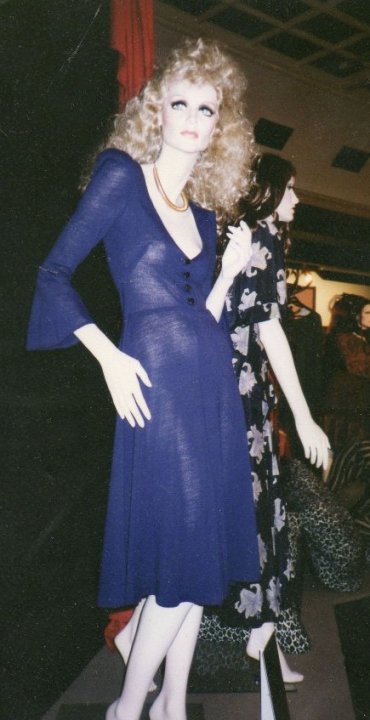
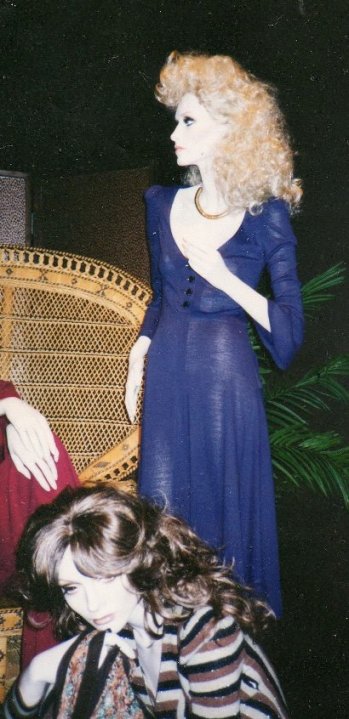
Another scene-stealing frock of mine which looks very threadbare but is not, even now 20 years later!
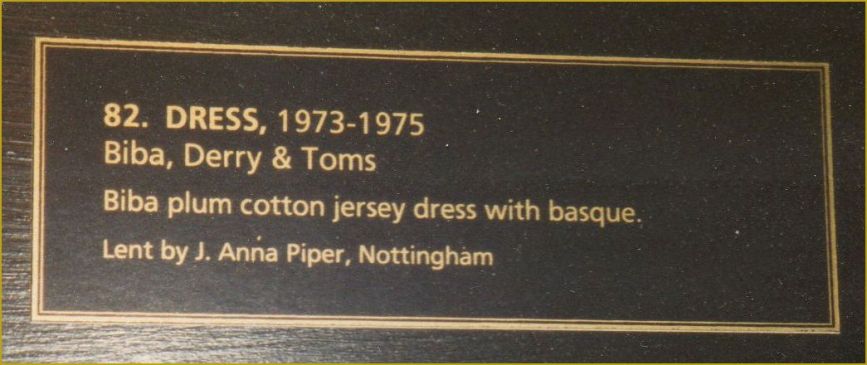

Whilst pottering about on the Internet (sorry, I meant surfing of course) I was actually amazed that, in 2012, there are a number of newspaper articles relating to the Laing Art Gallery's Exhibition still available - the Independent provides us with these two articles:
"Heaven was a place called Biba: For schoolgirls and cover girls, clothes at a certain shop in Kensington were to die for, and still are, says Roger Tredre"
 12th February 1993
12th February 1993
Why is it that everyone who bought clothes from a shop that shut in 1975 has kept them hanging unworn in the back of their wardrobe for almost 20 years?
When the Laing Art Gallery in Newcastle decided 15 months ago to stage a retrospective on Biba, fashion store for Sixties swingers, the organisers launched a nationwide 'Bring Out Your Biba' campaign, to encourage former customers to search through their cupboards. The gallery received thousands of replies and inquiries, as well as offers of clothes and memories. The exhibition, which opens next Friday, has struck a chord with a generation.
Biba was more than just a clothes shop. It was a shopping experience that answered the needs of a young generation enthusiastic for fashion, for the shock of the new. Biba attracted women of every age: mothers and daughters, models and film stars, such as Twiggy and Julie Christie, even royalty - all leapt on to the bandwagon of fast-moving fashion with strong elements of retro styling. The shop democratised fashion, making it accessible to the young and low-paid. Henceforth, no one had to look to the Paris catwalks and sigh with envy, because at Biba fashion was happening right before their eyes - and everyone could have a share in it.
Iris Griffin, now 62, used to queue up with her daughter outside the Biba shop in Kensington Church Street on Saturday mornings. 'It was the coloured knee-high suede boots that excited us; we went every week. And the word got around: they were mauve, they were pink, and they were so cheap. Biba seemed to put out things that ordinary girls liked.
'You can't imagine what Biba was like to our eyes: all those feather boas and hats and spangly tops,' she says. 'The clothes were so different from anything else around.'
Christine Archer, now a 47-year-old teacher living in Kingston, bought one of the earliest Biba products: a dress and matching headscarf, advertised in the Daily Mirror. For the exhibition, she has donated an outfit she wore to a wedding in 1969 - a knee-length coat over flared dogtooth trousers and a crepe blouse, with pink suede boots and a huge black straw cartwheel hat that, she says, 'wouldn't fit in the Mini'.
Ms Archer is a strong admirer of Barbara Hulanicki, who founded Biba and designed most of the items. 'I always thought Mary Quant was more expensive, and she didn't do the all-co-ordinated looks. Barbara Hulanicki was affordable and just as good as any French or Italian designers. The clothes were very carefully cut.'
Ms Archer used to make special trips up from Bristol to Hulanicki's Abingdon Road shop. Later she went to the shops in Kensington Church Street and Kensington High Street, and, finally, to Derry and Toms, the celebrated four-floor store that Biba took over in Kensington High Street. 'Shopping at Biba was a real social event, particularly in the small shops,' she recalls. 'People sat at window seats and met their friends. But I was always a bit disappointed with Derry and Toms. It didn't have quite the same atmosphere.
Sheila Pilkington, now 50, was manageress of Dorothy Perkins, directly opposite Biba in Kensington Church Street. 'The shop was dark and mysterious, very art nouveau, and incredibly tatty with piles of clothes all over the floor. The staff were very laid-back. We used to receive deliveries on behalf of Biba, but they never bothered to come and pick anything up.'
If the Biba girls were laid-back, it was because they felt themselves to be special. Mandy Bentley, 36, who worked at Derry and Toms for three years, says: 'I served all the celebrities - David and Angie Bowie, Bianca Jagger, Bryan Ferry, Valerie Singleton. But we didn't get that excited. We thought we were famous in our own right because people came in and asked if they could take our photo. I suppose it went to our heads a bit.
'There was a lot of lunacy among the staff. We were supposed to be the wild children of the Seventies, and the press was always going on about Biba girls caught with dope and in orgies. They exaggerated, although we did have a lot of fun. I remember being told off for having sword fights with feathers and plumes in the shop. I wore a uniform of brown dungarees, T-shirt and a hat which I hated.'
Like many of the Biba girls, Ms Bentley looks back to those days with unabashed nostalgia. 'All of us should have an opportunity to be original once in our lives,' she says. 'Biba gave us that chance. If Barbara Hulanicki opened another shop now and took us old cronies back, I'd be the first there - and I would take my daughters along, too. Mind you, they'd have to change our name. We'd be the Biba Golden Girls.'
Barbara Hulanicki and Stephen Fitz-Simon, a husband-and-wife retail team made in heaven, opened their first shop in 1963 in an old chemist's store in Abingdon Road, Kensington; they painted the walls navy blue and hung long curtains with a plum and navy William Morris print. Ms Hulanicki was determined to break with all the traditional ways of doing business. Her shop was the first to stay open until 8pm, she played Beatles' hits loud to turn on the shoppers, and turned a blind eye when customers stripped off to try on her clothes.
Ms Hulanicki now lives in Miami, where she designs fantasy interiors for hotels. I phoned her last week to ask what she made of the continued enthusiasm for Biba. 'I'm a bit shocked, to tell the truth. You think this sort of thing will only happen after you're dead.'
Right from the beginning, she said, Biba was a social meeting place rather than merely a shop. For years, Ms Hulanicki used to receive  letters from people who met at Biba, courted at Biba on Saturday afternoons, named their babies Biba, and wrapped them up in Biba purple nappies.
letters from people who met at Biba, courted at Biba on Saturday afternoons, named their babies Biba, and wrapped them up in Biba purple nappies.
The fun came to an end in the mid-1970s after Ms Hulanicki had lost control of the business to Dorothy Perkins. She slowly watched her empire subside in a series of boardroom battles that are described in painful detail in her autobiography, From A to Biba, published in 1983.
Allan Thomas, who designed prints for Biba on a freelance basis after graduating from Central School of Art in 1972, believes that the business also lost its creative energy in those final years. 'The big mistake was that they didn't shift the image. Fiorucci followed a similar formula, but he moved on and kept undating. By 1975, I was trying to show them new prints, but they always wanted the same, the typical Biba. They should have known that nothing is for ever in fashion.'
Like many who remember the original Biba, Thomas has reservations about today's early Seventies revival. 'Frankly, it was one of the ugliest periods of fashion. Much of it was absolutely dire.'
Hulanicki thinks this Seventies revival won't last long in its present form. 'When designers start using spots, stripes and leopard skin, you know they're in trouble. The interest in Biba suggests that fashion is in a transition stage. It's the start of a new feeling, but designers still have to develop their own look.'
Biba fashion was made for women with tiny shoulders and asparagus legs. Few women who bought Biba can still wear their clothes. Ms Bentley says: 'I have a black jersey dress in size eight, the anorexic norm for that time. There's no way I can get into it now.'
Years later, Ms Hulanicki frankly acknowledged that some of her clothes were uncomfortable. She said that the celebrated Biba smocks 'itched and stopped the girls' arms from bending'. Her long, skinny sleeves were 'so tight they hindered the circulation'. In the early days, she admits, her best customers were 'post-war babies who had been deprived of nourishing protein and grew up into beautiful, skinny people: a designer's dream'.
This week she pointed out that technological advances in fashion might make her clothes fit rather more successfully today. 'We never had stretch fabrics with Lycra, fabrics that move with the body.'
Itchy and uncomfortable, or stretchy and versatile, teenagers of the Nineties don't worry about such trifles. In the spring of 1993, the Biba look is back in again. To be young, size eight, and dressed in Biba (or a contemporary imitation), is to be in heaven. The shops may be history, but the spirit lives on.
'Biba, the Label, the Lifestyle, the Look' opens at the Laing Art Gallery, Newcastle-upon-Tyne, on 19 February till 6 June; at Aberdeen Art Gallery from 3 to 31 July; and Leicester Museum and Art Gallery from 21 August to 14 November.
Out of our closets: true confessions of a Biba Bird: Granny prints, feather boas, over-the-knee lilac suede boots, plum eye-shadow - Alexandra Artley wore them all with pride
14th February 1993
Like having predominantly orange Le Creuset cookware in your kitchen, a few Biba originals at the back of the wardrobe is a clear sign of having reached the springtime of your forties. It is not often that a British art gallery makes a mass appeal for exhibits from the middle-aged. But recently, when Caroline Imlah of the Laing Gallery in Newcastle upon Tyne put out the call to Bring Out Your Biba, a now-scattered generation of sharp dressers moved as one.
From all over Britain, Biba clothes, make-up, scent, shoes and feather boas poured in from staid-sounding married women still proud to be called Biba Birds. As if they were uncovering old expeditionary foodstuffs in the Antarctic, men even contributed unopened tins of black- labelled Biba soup and baked beans.
Barbara Hulanicki's novel idea, in inventing Biba in 1966, was to sell a dream of a whole life and not just bits and pieces to wear or use. For provincial youngsters like me whose parents still lived in a kind of genteel hangover of war-time austerity, Biba hinted at new exciting things that ordinary youngsters in the street were not supposed to know about - opulence, glamour, decadence and sex.
After the ding-dong of church bells in the North Riding, formal family meals cooked in aluminium saucepans, bracingly cold bedrooms and virginal home-made cotton dresses, Biba life seemed just the ticket. In Sunday newspapers, glimpses of the far-away Biba boutique showed a flickering world of crushed velvet sofas, long-fringed purple lamps, ostrich feathers, huge mirrors, potted palms of the Empire and accomplished languor. A typical Biba interior had the air of a junk shop-cum-bordello. The Biba 'lifestyle' seemed so potent because it suggested little more than the old British pastime of making love among the ruins.
Biba was entirely London-based (why the V & A is not taking the new Biba show is quite baffling) but Barbara Hulanicki very cleverly reached out to the frozen North by producing a glamorous mail-order catalogue. It was long and thin in chocolate brown, with the mysterious gold Art Nouveau Biba logo on the front. Inside it was full of moody pictures taken by photographers like Helmut Newton.
In 1968, after tuition fees, books and lodgings had been paid for, I blew my university grant quite shamelessly on Biba clothes featured there. Even if it meant living for the rest of the term on chips, buns and 10 horrible Players No 6 a day, the clothes were so irresistible that I simply had to have some.
It is often forgotten that for small, slight, women Biba clothes were a particular god-send at that time. Being narrowly cut, often on the bias, and with very high armholes, they actually fitted. Ordinary off-the-peg clothes did not seem to cater for small people then and cheap clothes that one had to wear most of the time had the grace and fit of Army blankets. The Biba colours seemed wonderful too - bitter chocolate and cream, murky pinks, duck-egg and assorted grege. Having skinny legs also became a virtue because Biba made very tightly cut lilac suede knee-boots with platform soles and, if you could manage to zip those on, an ankle sure was an ankle.
Sometime in the late Sixties, the Dorothy Perkins chain began to sell Biba cosmetics and then, for those who rarely visited London, the Biba Look could be complete. Instead of motherly suggestions that nice girls only needed a dab of face powder and a bit of pink lipstick, this black-and-gold boxed Biba stuff had the utility of modern Body Shop packaging plus a hint of the artifice of the theatre.
The whole purpose of Biba make-up was to be an innocent vamp. At the fair end of the range, liquid make-up was based on a chalky pale yellow, fixed with near-white or translucent powder. Then for the eyes came plum eye-shadow, grape, blue-bottle, even the astonishing panda-style black. Lipstick was deep mulberry or pale lilac worn in the manner of Clara Bow, and all topped off by gallons of that distinctive Biba vanilla-pod pong. At the start of a week I took special care to lash on ounces of all this stuff before sitting in adoration before my wonderful tutor, Dr Arnold Kettle. What this high-minded family man made of these waftings from the casbah at nine-o'clock on a Monday morning when he was trying to discuss 'the rise of the novel' I now blush to think.
Certainly, as one contributor to the Newcastle Biba show wrote of the rather overpowering effect of Biba cosmetics in broad daylight: 'We thought we were the bee's knees but the lads thought we were ghouls.'
In 1972, after moving to London, I caught up with the new Biba department store in the old Derry & Toms building on Kensington High Street. Looking back it was the most extraordinary place although it turned out to be the tomb of the Biba cult. Unusually for a department store, it seemed to operate in almost total darkness. To encourage people not to overcrowd the lifts, the 'Hallelujah Chorus' was piped down the central stairs to tempt shoppers to walk up. By now, the store sold not only women's and children's clothes, but menswear, Biba wallpaper, Biba black and purple matt paint, Biba lino, Biba satin sheets, even Biba chocolates and bird's nest soup in a food department from which the distinctive Biba tins were rarely opened but just left as status symbols on a kitchen shelf. I must say, even for those of crazily romantic temperament, shopping for tins of Biba cat food with a torch seemed a little over the top.
Nowadays I wish I had the power to double the state grant of every student in Britain so that like us - the very pampered post-war Welfare State generation - they too could relax a bit and sometimes buy nice things. When living in cold derelict bed-sits under intense pressure to succeed, all students need a few glamorous things in their lives just to keep them going. Like owning a few Biba clothes and a bit of luxurious make-up, there is nothing that lifts the spirits and stiffens the will to go on as the occasional possession of what we take, however absurdly, to be the beautiful.
Biba: The Label, The Lifestyle, The Look is at the Laing Art Gallery, Newcastle upon Tyne, from Friday to 6 June, Aberdeen Art Gallery 3-31 July, Leicester Museum and Art Gallery, 21 August-14 November.
And we are still reading these, twenty years on which I think is rather remarkable!
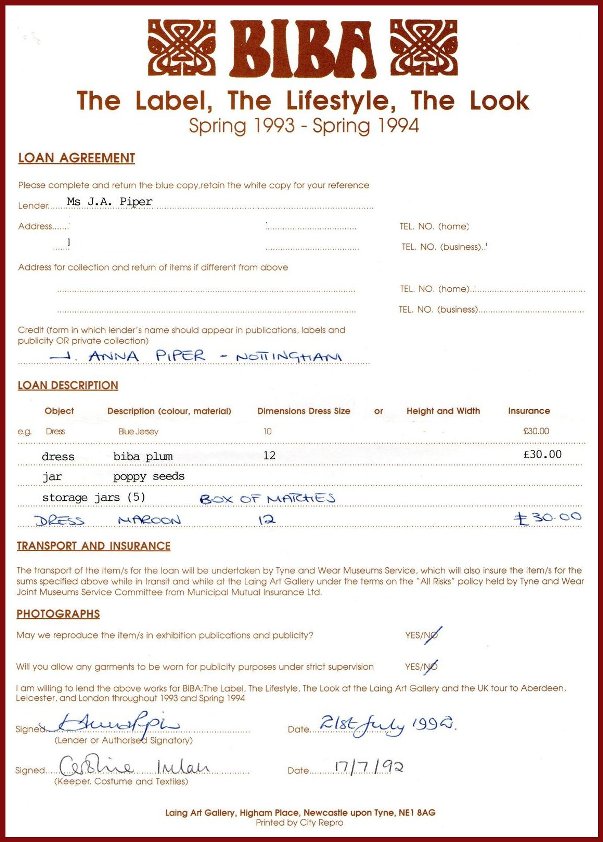
The original loan agreement for the Exhibition
Page refreshed : 18th October 2019
